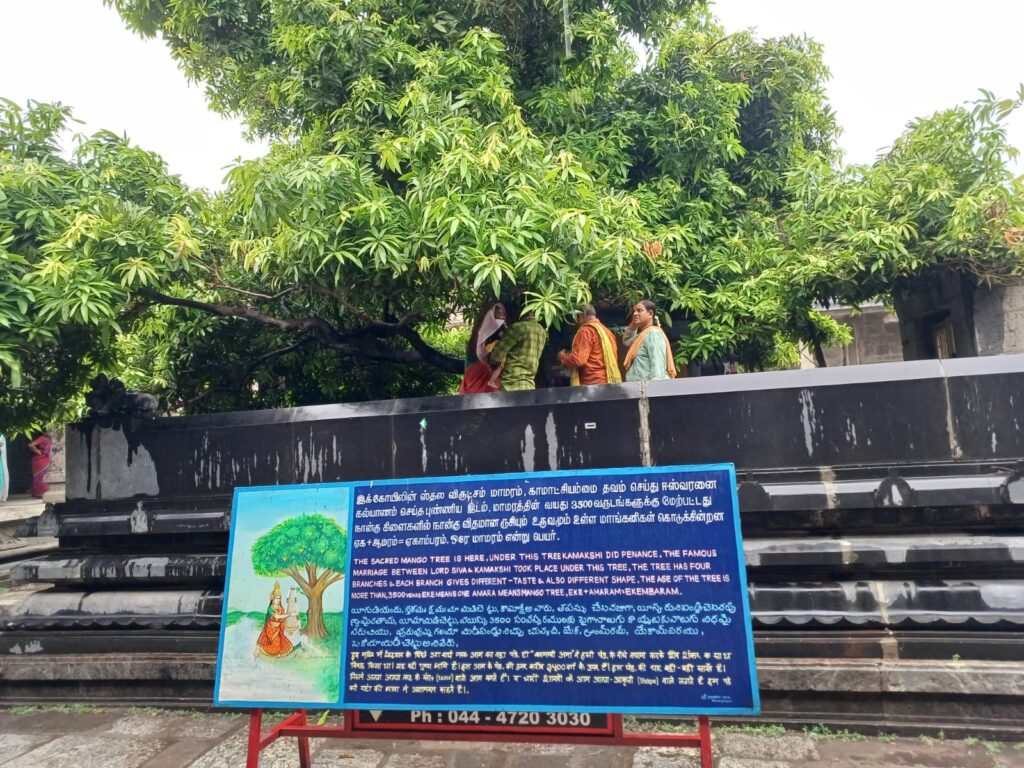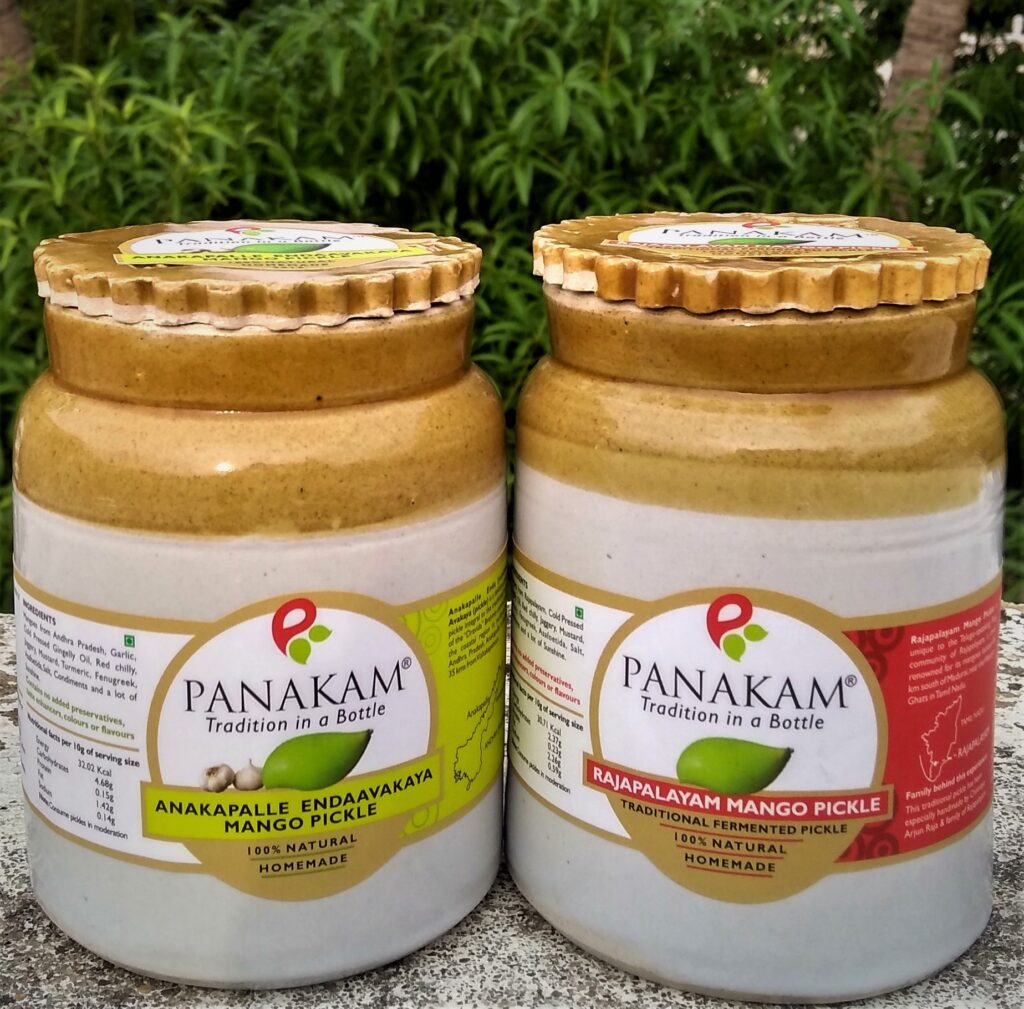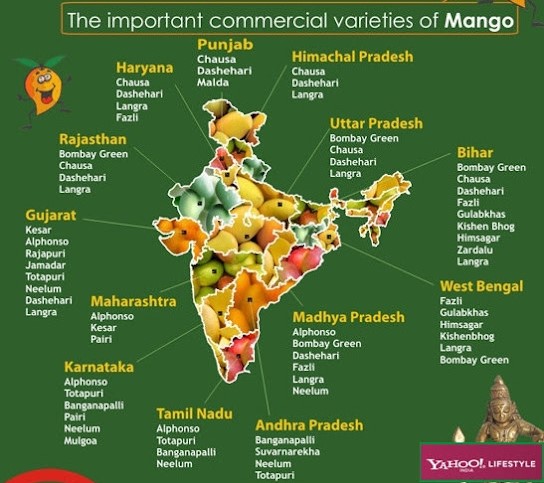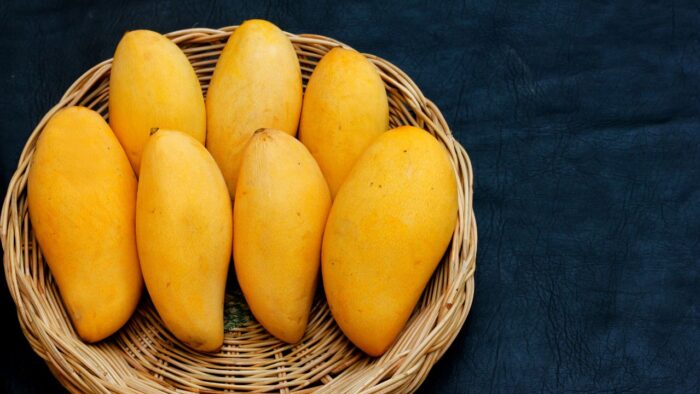Last month, on a visit to the temple town of Kanchipuram in South India, I was walking around the sthala vriksha (temple tree) of the Ekambareshwarar temple. The day was wet, a welcome respite from the hot summer of Tamil Nadu. A mango fell into my hands—a prasadam from the Gods.
This 3,500 year old mango tree is the one under which Parvati, as Kamakshi, worshipped Shiva. The tree has four branches each believed to represent one of the four Vedas and each bearing mangoes of four different flavours and shapes.

In the Vedas, mangoes are described as the ‘food of the gods’, as ‘phalotta-ma’ in the Sankhayana grhya Sutra (http://sacredtreesbhu.com/). It is believed to be the symbol of Prajapati, the lord of creation. According to the Skanda Purana when the Gods and demons churned the sea for nectar, the Kalpavriksha or wish fulfilling trees - Parijata, Mango and the Santanaka emerged.
Considered auspicious, mangoes form an integral part of Indian worship rituals such as Purna Kumbha or jala ghata, denoting life, love and fertility. People of Assam take a little green mango and jute leaves mixed with mustard and salt during Bihu. Priests sprinkle water with a small shoot of mango to shower their blessings during ceremonies. The fruit is among the offerings made to ancestors or pitrs as mentioned in the Brahma Purana. The Matsya Purana mentions the use of mangoes while keeping fasts or vrata. The tree is sacred to Buddhists too—Buddha’s favourite meditation spot was under a mango tree, and his disciple Amrapali presented him with a mango grove.

July is a time for satiated reflection after a summer full of mangoes. It is also a busy time for pickling and making sweet preserves. On July 22, for several decades now, the world has celebrated World Mango Day. The study of the attractiveness of India’s national fruit to people around the globe be it through the fruit, pickles, chutneys, the traditional recipes and tastes, is the forte of the Center for Soft Power.
Mangoes have been an integral part of food soft power for a long time now. The Portuguese took the Hapus and grafted it. They renamed it Alphonso after a King, who wanted a variety that could be cut easily and eaten with forks and spoons. Christian Reynolds, City, University of London, in his article “Tipping the Scales: A New Understanding of Food’s Power in the Political Sphere,” (https://ssrn.com/abstract=2523871) says two principles shape food soft power – the political-economic conceptualization of food and its cultural-symbolic conceptualization. Only when both these are considered together do we get a ‘concise picture about the farming, consumption, and culture of global food.’
Reynolds differs from Joseph Nye, soft power expert, who avers that, “Food consumed without ideology is just cultural propaganda. Soft Power must exert attractive power, power that influences the way governments (and their people) act towards each other,” (Nye, 2004). Reynolds on the other hand believes that “even the eating and drinking of another culture’s or nation’s food is a power victory, albeit a small one. This victory is a smaller coercion because it is not due to the attraction and a want to become like another but is just the acceptance and recognition that there is another and the embracing of the other by consumption… this is the first step for soft power to be effective, and that itself is a power victory.”

Political Economic: According to the Ministry for External Affairs (How India is sweetening the prospects for mango exports - IndBiz | Economic Diplomacy Division | IndBiz | Economic Diplomacy Division), India produces almost half of the world’s mangoes. Almost 1,000 varieties of the fruit are grown here, but only 30 are used commercially, including Alphonso that forms the bulk of exports from the country. Other popular varieties include Kesar, Langra and Chausa.
In a recent article https://indianexpress.com/article/cities/pune/indian-mangoes-us-exports-double-8621005/, Kaushal Khakhar, CEO of Kay Bee Exports, says that India’s mango exports are expected to more than double in the current fiscal year, crossing 2000 tonnes as against 813.5 tonnes in 2022-23.
The articles quotes the mango-for-bikes deal of 2007 when India allowed imports of Harley-Davidson motorbikes from the US in return for the latter opening its market for Alphonso mangoes.This marked the lifting of a 18 year old ban on mango imports to the US due to fruit fly infestation. Khakhar says that, “There is a lot of demand coming from supermarkets and stores (in the US), especially for Kesar mangoes.” Kesar is considered to have a long shelf life, and the recent fall in air-freight charges have favoured exports to the US this year.
India, while having the advantage of a long period of availability of mango for export, has lost ground to countries like Venezuala, Costa Rica, and Mexico. This is because most international trade in fresh mangoes takes place within short distances. Perhaps with a better protocol of mango export and dealing with the variable phyto-sanitary protocols of importing conditions, India can sell its mangoes better. Dr Bhaskar Savani, President and CEO Savani farms, USA, says, “Irradiation regimes on mangoes have created confusion and is the main hurdle to export of Indian mangoes to America. Seventy percent of Americans have not tasted Indian mangoes and hence there is a need to have a National Mango Board to promote export of Indian mangoes.” He stresses that 10 prominent varieties from India should be promoted for export to North America.
According to a report by the National Horticulture Board - Mexico, Haiti and Brazil account for the majority of North America’s imports. India and Pakistan are the predominant suppliers to West Asia. Southeast Asian countries get their supplies mostly from the Philippines and Thailand. The European Union sources mangoes from South America and Asia. According to the International Mango Conference 2018 proceedings the USA, European Union, China, Persian Gulf and Canada are the major markets for mangoes in the world. Speaking at the conference, Dr Victor Galan Sauco (Research Professor, retired) Institute Canario de Investigaciones Agrarias, Spain, remarked that “Exotic varieties can be cultivated for world market trade but Indian varieties are good for high quality niche markets.”
The Indian government is exploring new geographies for exports. For the first time this season, India shipped 2.5 tonnes of GI-certified mangoes to South Korea. These mangoes were treated, cleaned and shipped from the APEDA-assisted and registered packhouse and vapour heat treatment facility at Tirupati, Andhra Pradesh. Another way to push exports is innovation in food processing. This will increase the shelf life of the fruit and also help overcome the issue of distance, say experts.
Chennai based entrepreneur, pickle maker and wine educator Chinmaya Arjun Raja founded Panakam - Tradition in a Bottle in 2015 to celebrate the diverse gastronomic traditions of South India. His products are handmade by families who follow recipes handed down for generations using local ingredients. “When you speak about pickles you have to talk about two kinds of pickles - the major one being the industrial processed industry. Most of the pickles available in the US and even in France are commercial pickles, usually made in the UK. This is usually salty, oily and full of additives. When I go to France for my wine and food business, I usually gift pickles to my customers. They like this variety and say they have had bad experiences with pickles that are too salty and oily. I am sure if pickles are made in the traditional, artisanal way, I am sure there is a big market for pickles.”
Raja says the problem is that artisanal pickles cannot be made as an assembly line. He started making them in order to preserve a tradition where natural ingredients are used and made in a healthy way, with global appeal. He says that thousands of tonnes of mangoes are wasted every year in India, because of the lack of a cold storage and processing chain. East Karnataka, South Andhra And North Tamil Nadu are the main hubs of cultivation of mangoes “Even here so many tonnes get wasted before reaching the market. There’s a big demand and if we can put up a few processing plants near the orchards, it would help.”
Cultural Symbolic:
While our Vedic traditions have hailed the mango, its flowers, and leaves as symbols of prosperity and auspiciousness, botanists have hailed it for its complex molecular structure. Indian horticulturalists have celebrated the molecular secrets of the Alphonso mango flavor, observing that over 85 volatile compounds determine its flavour and aroma, and these contents vary with location. Lactones and ketones are the important volatile components. Also, unsaturated fatty acids are higher in Alphonso than in Kent mangoes (a very popular mango variety grown in Florida).
This potency finds its mark in the flower-tipped arrows of Kamadeva, one of whose five arrows is a mango blossom. It also finds mention in Kalidasa’s play Shankuntala:
‘O mango-twig I give to Love
As arrow for his bow,
Most sovereign of his arrows five,
Strike maiden-targets low.’
The earliest literary reference of mango fruit as ‘Aamram’ (in Sanskrit) comes from the Satapatha Brahmana. The other texts that mention them are the Ramayana and Mahabharata, the Puranas, literature of the medieval period, and other folk and regional literature.
Fruit to motif is another interesting offshoot of this beloved fruit and studied extensively by Anamika Pathak (Ph.D.), Former Curator National Museum, New Delhi Chairperson Textiles and Clothing Research Centre, New Delhi. While the sweetness of fruit has inspired farmers, its shape has inspired artisans, making it a motif for panels, jewellery, textiles, weavers and embroidery, says Pathak in her thesis ‘Mango kairi kalka paisley: Design in Indian art from architecture to textiles.’
In modern times, culture, tradition and agriculture come together in tastefully curated mango festivals, where growers meet consumers across the country. Take for instance the mango festival curated by Hanu Reddy Raghava Farms located in Othivakkam, near Guduvanchery. The farm produces some of the sweetest Banganapalli mangoes in Chennai, with fruit fully maturing on the trees. It has a 156 ft long table, built of cyclone felled Casuarina and Eucalyptus wood, where people gather around to sample mangoes. The promoters hope to give back to the farming community, and bridge the gap between the farmer and the market – both local and global. The festival aims to inspire farmers to sell experiences, providing them with an additional source of income while also promoting rural tourism.
Through this festival, Hanu Reddy Mango Tourism is also promoting mango tourism, showcasing the diversity and richness of India's agricultural landscape. “The Great Mango Festival is not just about having fun and enjoying delicious mangoes, it's also about raising awareness about sustainable farming practices and the importance of supporting local farmers. It's an opportunity to put India on the map for its mangoes and farming practices.”
In the US, Boston based brothers Van and Sumit Sharma will be launching their company Rupee’s signature Mango Wheat Ale on World Mango Day. The brothers wanted to brew an easy to drink summer ale “which is smooth with hints of tropical aroma and mango flavour.” The brew is based on the Chaunsa mango and is in line with their aim of pairing brews with the spicy food they grew up with.
Maybe like Thailand which saw an instant soft power surge of mango sticky rice after teenage rap sensation Danupha "Milli" Khanatheerakul ended her show by eating it at Coachella, spontaneous endorsements by influencers along with national policies can showcase what is for sure ambrosia for the ‘aam’ janta!





